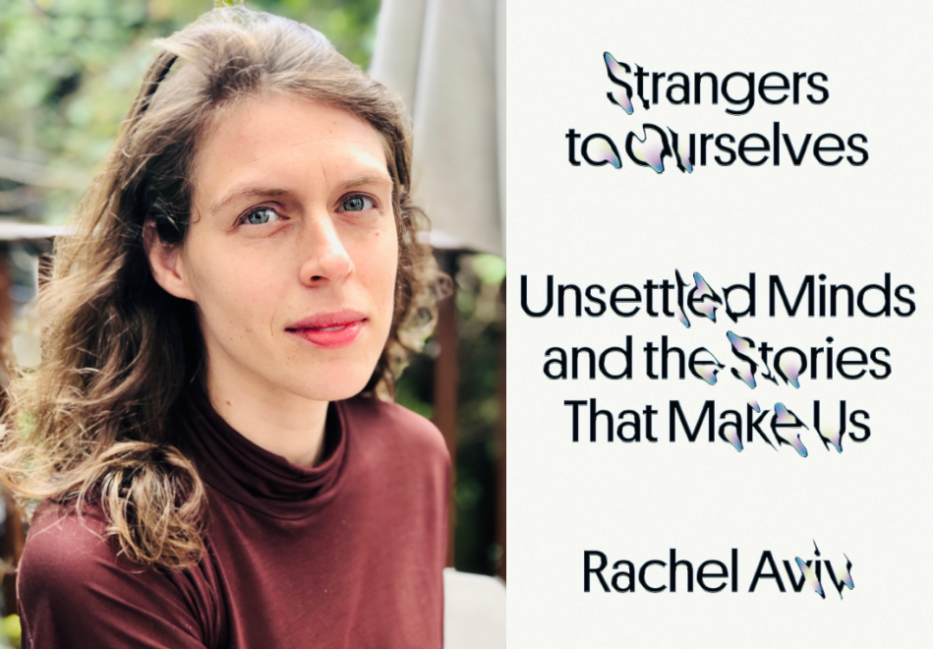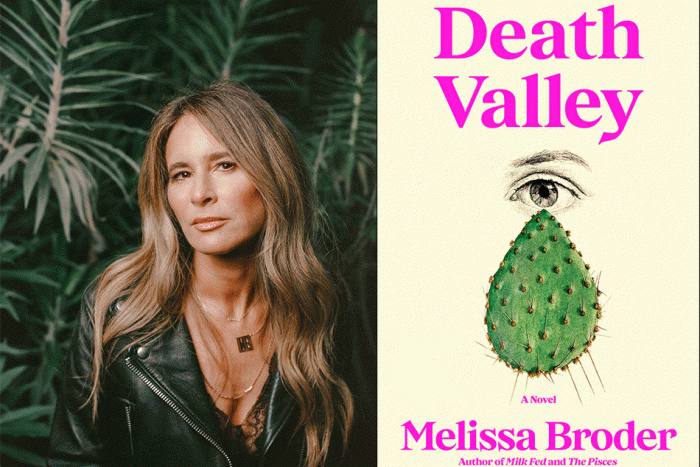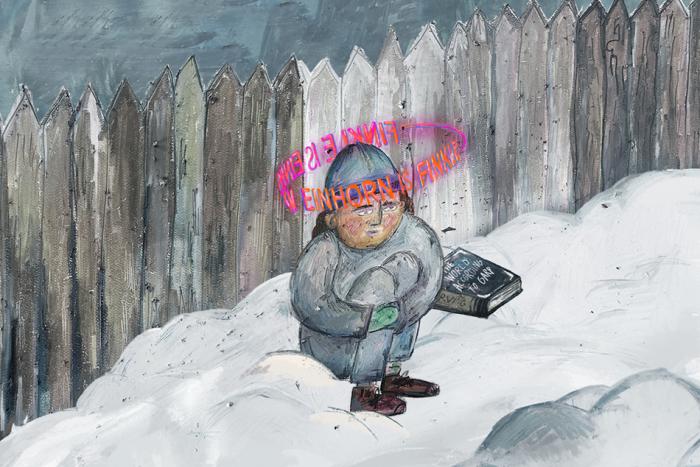“There are stories that save us, and stories that trap us,” writes Rachel Aviv, “and in the midst of an illness it can be very hard to know which is which.” In her first book, Strangers to Ourselves: Unsettled Minds and the Stories That Make Us (Anchor Canada), Aviv, an award-winning investigative journalist, turns her careful focus on mental illness: stories and storytellers, traps and reprieves. Aviv shows how these stories both mirror and are shaped by systems of race, class, gender, generation, and context. But it is chiefly and essentially about six people, all of whom are represented with startling clarity.
One by one, Aviv juxtaposes the stories of Ray, an ambitious nephrologist; Bapu, a Brahmin wife and mother in Chennai; Naomi, a young incarcerated mother; and Laura, a Harvard graduate with family ties to FDR. Each chapter is written with an intimate knowledge of her subjects’ lives, constructed from an archive of personal writing—diaries, memoirs, poems, letters—and interviews. The four eponymous chapters are bracketed by a prologue and epilogue that draw on Aviv’s own life, featuring a young woman named Hava.
A New Yorker staff writer since 2013, Aviv’s meticulously reported pieces often pursue stories that, on the surface, resist being conclusively told. One of the chapters in Strangers to Ourselves doubles back on a piece first published in 2019 about the difficulties of withdrawing from psychiatric drugs, which becomes even more nuanced within the contained arc of the book.
Strangers to Ourselves is, as Aviv explains, a prismatic experience: each chapter refracts in the light of what came before and what comes next. With her artful collation of different voices, Aviv shows that there is no clear transcription of mental illness, nor is it discrete from the realities in which that illness expresses itself. But there is beauty in getting close to it, as she does, piercing the loneliness that so often encloses stories of mental illness. The results are revelatory.
~
Naomi Skwarna: In the prologue, you mention that the book is about “missing stories.” I was wondering when, if you recall, you had the idea to bring all these missing stories into something whole?
Rachel Aviv: I knew I wanted to write a book in this realm as early as 2012. I’d written a piece for Harper’s about people who were in the very early stages of psychosis and trying to figure out if and how this diagnosis might affect the rest of their lives. Talking to these people, I started to realize that I didn’t know what the subjective experience of psychosis was. I would ask them to describe their symptoms and they just couldn’t describe it. They were having an experience that did not have the potential to be translated into words.
That was a seed of it: this sense of how difficult it is to communicate the experiences of mental illness and how, because of that difficulty, we allow expert language to define those experiences. That can be great, but it may at times alienate you, or make it harder to talk about the thing that is causing the most distress. We talk about symptoms, but not about all these really unusual experiences in between them or surrounding them. No one’s putting it into words. I think that was the core of the book for me.
That’s such an interesting place to work from—trying to find some common language for these stories in a way that isn’t diagnostic.
When you think about what a writer can contribute to medicine, you know—I don’t think I should pretend that a writer can do much—one thing that a writer can do is try to describe things that are not being described.
The Laura chapter is adapted from a story you published in The New Yorker in 2019. The new version adds quite a bit to the original piece, and also changes directions a little bit. Did the work you did on the other chapters inform your revision at all?
I wanted to distance myself a little bit from some of the ideas [in the original piece]. In The New Yorker, it was very much about the pain of withdrawing from medications, which I think is a really important issue that should be talked about more. In the book, I was thinking more about Laura’s explanation for her own recovery. I hadn’t put as much pressure on thinking about that in the original story, but, in terms of my own experience taking antidepressants, I started to wonder, “what do I do about the fact that I still feel better when I take these [medications]?” I’m unsettled by it, and I don’t know what to do with that.
Psychiatry tells one story about what ails people, and then there’s a way of almost doing a complete 180 and telling the opposite story—“all my problems are because of psychiatry.” That also felt too reductive and too simplistic. I know Laura has a more complicated view of that, but I wanted to draw attention to the fact that dismissing the whole enterprise is just as reductive as feeling like psychiatry is the answer.
Something that I found quite graceful is how the book has a kind of mirrored structure. The prologue details the story you shared with Hava as children, and then moves on to Ray’s chapter. Laura’s story is almost an inversion of Ray’s, and her chapter then transitions into the epilogue, where you come back to yourself and Hava in the present. What was that organization process like? How did you approach putting these stories in order?
That was the hardest part of the book. I had thought that by writing a number of stories, as opposed to one continuous story, I was solving the problem of why so many books feel like the stories are too long. But I didn’t realize that I was creating this other huge problem, which was that you’re not just telling the individual stories. These stories need to be telling a larger story.
My editor, Eric Chinski, said early on that the book should be a prism: each time you look at a set of questions from a different angle, your answers to those questions change, and that’s okay. So, on the one hand, I wanted it to be loosely chronological, but on the other hand, I wanted the ideas to develop over the course of the book. I also wanted there to be a sense that one chapter would then challenge or complicate the ideas in the previous chapter so that there was a sense of instability in terms of what a reader takes away. I did flip the chapters around a few times before I figured out how to best approach that sort of ideal, structurally.
Yes, I guess you have to test out how they complement each other.
I thought Naomi should end it at one point. It was the last story I reported, and I knew there was a missing piece in the book, which was how race in America has been intersected with psychiatry. I came to that chapter, unlike some of the other earlier ones, knowing that it was sort of the heart of [the book].
Why did it feel important to integrate your own experiences [of being diagnosed with anorexia] into a book that is otherwise focused very deeply on other people?
I don’t think I would have written the book without my own experience. I don’t think I would have even had the idea for the book. To articulate the kinds of questions I had, I needed to describe the personal place that they came from. When I worked on the story about the Swedish children, I had a way of framing my own experience that I’d never had before.
For a long time, I felt [my experience] was kind of boring and I didn’t really know what to make of it. One therapist was like, “you were rejecting your mother and the way to reject your mother is to reject milk, because milk is with the mother, and that was why you stopped eating.” Or people would give these kinds of explanations that maybe were true, in some sense, but didn’t feel interesting to me. It was working on that story and reading Ian Hacking’s work about the looping effect that crystallized a lot of the questions I wanted to explore. And then on a formal level, I felt like it was only fair to write about myself if I was asking other people to talk about themselves in this way. I wanted there to be a sense of us all in it together.
All of the people you wrote about were in different ways prolific writers of memoir or diaries or poetry. I wondered if you had thoughts on the relationship between writing and mental illness?
I love diaries. I think that they’re an amazing way for someone to describe an experience in the moment, before it’s been refracted and shaped by other people’s interpretations of what they went through. But then a friend said to me, “All of these people are really beautiful writers, and yet they’re all struggling with the sense that their own writing and their own storytelling about their mental illness is fundamentally lacking.” They needed to look to others, other experts, to tell them what they’re experiencing and tell them what’s happening to them.
I was interested in that tension between: yes, they were telling their own stories, and they were describing what was happening in their minds, but they also felt like there was some fundamental inadequacy, or they didn’t trust their own narration. That was an interesting question to me. I was interested in the gap between the way they describe themselves and the way others describe them, but I think that they too were aware of that gap, and sort of suggestible: “Maybe the way I’m describing it isn’t right, maybe that expert had it right all along.” It seemed like they felt there was something suspect about their own words.
Early on, you apply a very particular meaning to the word insight, and you use it throughout the book, often in relation to psychiatric insight—the degree to which someone knows that they’re experiencing mental illness, in simple terms. But there’s a lot of depth to the way you use it, and I wondered how you feel about that word now?
My editor actually pulled that out—that so many of the chapters were circling around this question of insight. It’s something I have thought about a lot. I wrote a piece in 2011 about a woman who escaped from a psychiatric hospital and lived on apples for a month. The rift between her and her doctors was that they said she didn’t have insight. They wanted her to be able to use their language to say, basically, “I have a mental illness and I know that it starts in my brain, and I need to take these medications,” and she just wouldn’t say that sentence. I remember feeling so struck by the fact that there were so many commonalities between what she wanted and what her doctors wanted. She wanted a house, she wanted to be with her family, she wanted to eat well. They agreed on those things, but they were getting stuck on this question of whether she had a mental illness or not. The doctors were so focused on getting her to acknowledge her mental illness that they couldn’t agree about these other things.
I was struck by this very subtly paternalistic idea that’s baked into insight, in the sense that doctors are looking for a certain way of understanding an illness, and if a patient is not expressing it through that framework, they’re seen as non-compliant. But then the flip side is that the patient, if she’s being told that she’s not “getting it”—that alienates her from care.
I do think it’s an amazing word. We don’t have many words that say, “How accurate is our own understanding of what’s happening in our minds?”
It felt even more enriched by the way you came back to it through the chapters. Another usage that caught my eye was when you referred to medication as “technology.” I’ve never seen psychotropics described that way.
I was remembering this line from a Nikolas Rose book called Governing the Soul—this idea of “technologies of the self”—I think that’s the phrase that gets used. Vikram Patel started a nonprofit in India to promote mental health, and I think he said something like, “People don’t see praying as a mental health intervention. They see it as a placebo, because it’s not a technology. It’s not putting some sort of chemical into your body. I don’t know why that isn’t seen as a sort of biological intervention, because even if it’s a placebo effect, if it makes you feel well, it changes your biology.” So this idea that only something external—medication that’s made through technology—can affect biology, I think he’s questioning, and I think that term, “technology,” maybe draws attention to that. There is a feeling that technology is going to make us healthy and so we’re going to ignore other interventions that are not high-tech.
Your interviews seem to require a great deal of delicacy. You’re often talking with people—I’m thinking of Naomi and her family—about some of the deepest kinds of suffering in their lives and the effects it’s had on them. How do you approach these types of interviews?
Something that feels natural to me is to not be judgmental, and I think I make that very clear in conversations with people—that if I were in those situations, I would probably make similar choices. I don’t want them to feel ashamed, or that there is any reason to feel ashamed. Understanding what they were experiencing in that time, I think, can help dispel the sense that someone should be ashamed of doing certain things. I also like to establish what the goal is for the person I’m writing about. What do they want from telling their story? I don’t want to tell someone’s story who doesn’t want their story told. I want them to feel engaged in the process, and like they have something to contribute, which they’re doing through telling their story.
One of the chapters that I had wanted to write was about a man who was almost the reason I finally decided to do the book. But after about a year or two of talking, he decided he did not want to be involved. In that moment, I felt like, “Oh, he was dropping little hints earlier on. I should have listened to those hints rather than getting so far along.” I want it to feel collaborative, like we are aligned in certain types of understandings about what telling their story can do in the world.
It does feel like a very collaborative book in the way you incorporated so many different voices, even posthumously, like Ray and Bapu. Every quote adds something vital, like the man you spoke to who said that stories about mental illness always follow the same arc. “They are, essentially, stories of haunted houses.”
That was the man I was originally going to write about!
Oh, well, the inclusion of his voice, even minimally, was so incredible.
He was an amazing person. You can see why I wanted to write a chapter about him.
It’s interesting to know that he’s still at the edges, especially given that beautiful quote from him.
He’s a force that shaped the book. I had to put away all that research, but it was okay because those conversations with him still shaped me.






